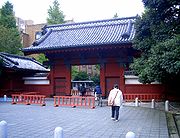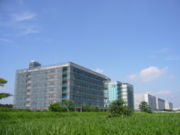- The University of Tokyo
-
Die Universität Tokio (jap. 東京大学, Tōkyō Daigaku, abgekürzt: 東大, Tōdai) wird generell als die Universität Japans mit dem größten Prestige angesehen.
Die Universität hat fünf Standorte sowie zehn Fakultäten mit insgesamt ca. 28.000 Studenten, von denen 2.100 Ausländer sind. Obwohl so gut wie jeder akademische Zweig an der Tōdai unterrichtet wird, ist sie durch ihre Jura- und Literatur-Fakultäten bekannt. Viele wichtige japanische Politiker sind Absolventen der Tōdai.
Der Hauptcampus liegt auf dem ehemaligen Grundstück von Kaga Yashiki, einem Feudalherren der Edo-Zeit. Die bekannteste Begrenzung des Universitätsgeländes, das Akamon (赤門, dt. „Rotes Tor“), ist ein Überbleibsel aus dieser Zeit. Das Symbol der Universität ist die Ginkgoblüte der vielen Bäume in der Gegend.
Die Universität wurde 1877 von der Meijiregierung unter dem derzeitigen Namen gegründet, wurde dann jedoch zuerst 1886 in Kaiserliche Universität (帝国大学, Teikoku Daigaku) als damals einzige Universität Japans und 1887 in Kaiserliche Universität Tokio (東京帝国大学, Tōkyō Teikoku Daigaku) als eine der Neun kaiserlichen Universitäten umbenannt. 1947, nachdem die Japaner im Zweiten Weltkrieg besiegt wurden, bekam die Universität wieder ihren ersten Namen. Sie gehört seit 2006 dem Hochschulverbund International Alliance of Research Universities an.
Inhaltsverzeichnis
Standorte
- Hongo-Campus (Bunkyō, Präfektur Tōkyō)
- Komaba-Campus (Meguro, Präfektur Tōkyō)
- Kashiwa-Campus (Kashiwa, Präfektur Chiba)
- Shirokane-Campus (Minato, Präfektur Tōkyō)
- Nakano-Campus (Nakano, Präfektur Tōkyō)
Fakultäten
Heute hat die Universität Tokio zehn Fakultäten:
- Jura
- Medizin
- Ingenieurswissenschaft
- Literatur
- Naturwissenschaft
- Agrikultur
- Wirtschaftswissenschaft
- Allgemeinbildung
- Pädagogik
- Pharmazie
Die Fakultät für Allgemeinbildung besuchen alle Studenten zwei Jahre lang, einige Studenten bleiben dort zum interdisziplinären Studium. Sie hat fünf Standorte, aber die meisten Studenten besuchen zwei von ihnen: anfangs zwei Jahre den Komaba-Campus und danach zwei Jahre den Hongo-Campus.
Außerdem hat die Universität viele Forschungsanstalten in Japan, wobei viele ehemalige Forschungsanstalten der Universität Tokio heute unabhängige Institutionen sind.
Absolventen
Viele bekannte Japaner absolvierten ihr Studium an der Universität Tokio. Kronprinzessin Masako schrieb sich nach dem Abschluss ihres Studiums an der Harvard University als Studentin der juristischen Fakultät ein. Nach einem Jahr musste sie sich aber exmatrikulieren, da sie das Staatsexamen zur Diplomatin bestanden hatte. Ihr Vater Hisashi Owada, heute Richter des Internationalen Gerichtshofes, war Absolvent der juristischen Fakultät.
Andere Absolventen sind z.B. (Familienname zuerst):
- Richter des Internationalen Gerichtshofes: Tanaka Kōtarō (auch Professor dort), Oda Shigeru.
- Premierminister: Yoshida Shigeru, Kishi Nobusuke, Nakasone Yasuhiro, Miyazawa Kiichi u.a.
- Wissenschaftler: Sasaki Takeshi (heute Rektor, Politikwissenschaft), Hasumi Shigehiko (ehem. Rektor, Kulturwissenschaft), Yoro Takeshi (ehem. Professor der medizinischen Fakultät, daneben auch Schriftsteller von Bestsellern), Kondō Jun (theoretischer Physiker, Nationalen Institut der Hoche Industriellen Wissenschaft und Technologie (AIST)), Itō Kiyoshi, Mathematiker, u.a.
- Schriftsteller: Mori Ōgai, Natsume Sōseki (bekannt als Abbild auf dem 1000 Yen-Schein), Kawabata Yasunari (Nobelpreis-Träger), Ōe Kenzaburō (Nobelpreis-Träger) usw.
- Andere: Uekusa Kazuhide (Wirtschaftswissenschaftler), Horie Takafumi (Vorsitzender von Livedoor), Yuasa Takashi (Internationaler Rechtsanwalt), Takata Mayuko (Schauspielerin), Takahata Isao (Regisseur), Ōkawa Shūmei (noch zu Zeiten der Kaiserlichen Universität Tokio), Nishida Kitarō (Philosoph).
Weblinks
- Website der Tōdai - Japanisch und Englisch
35.713333333333139.76222222222Koordinaten: 35° 42′ 48″ N, 139° 45′ 44″ O
Wikimedia Foundation.



